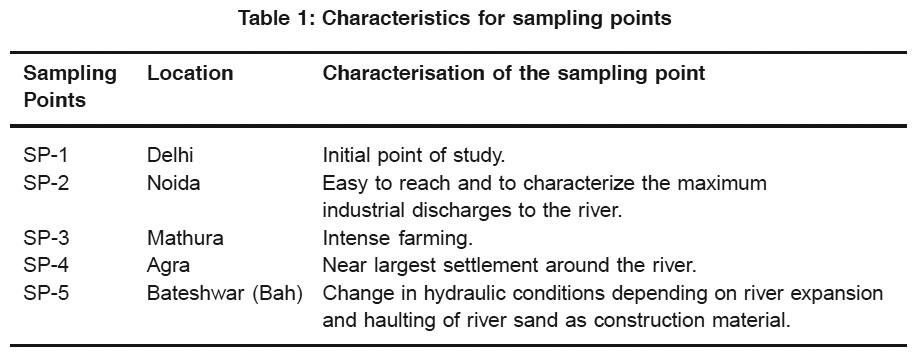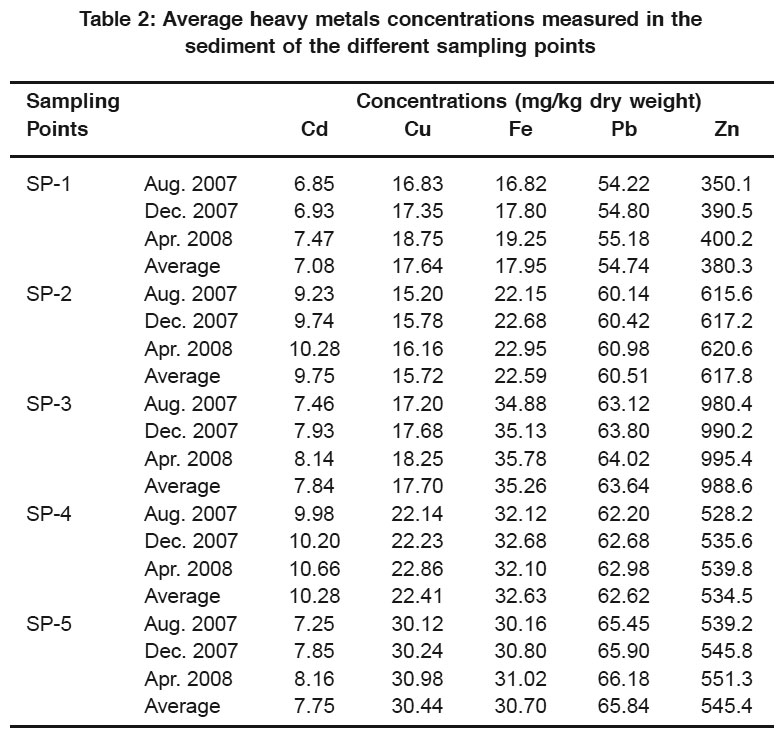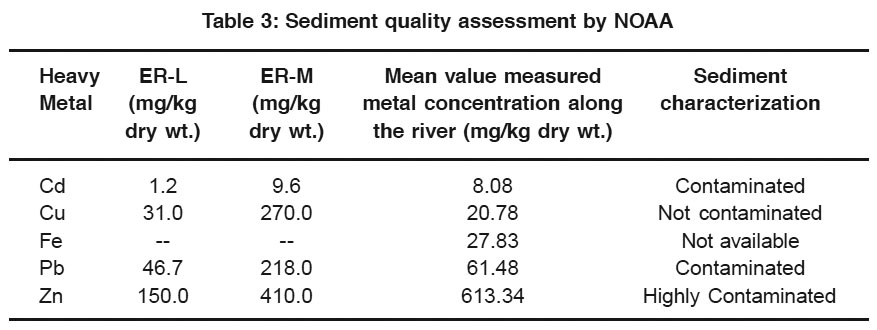Study of seasonal variation of heavy metal concentrations in bed sediments of Yamuna river
P.K.S. CHAUHAN1 * and R.K. PALIWAL1
DOI: http://dx.doi.org/10.12944/CWE.4.2.31
The present deals with the study of the variation of the heavy metal concentration in bed sediments against the flow rate of Yamuna river in Northern India. Five different sediments samples were collected from different places under low and high flow conditions during August to April and analysed. The values obtained were compared with National Oceanic and Atmospheric Administration (NOAA). There was heavy metal pollution with respect to Cd, Pb and Zn in the Yamuna river. The contamination of heavy metals in sediments of river increase with decrease in flow rate of water.
Copy the following to cite this article:
Chauhan P.K.S, Paliwal R.K. Study of seasonal variation of heavy metal concentrations in bed sediments of Yamuna river. Curr World Environ 2009;4(2):439-442 DOI:http://dx.doi.org/10.12944/CWE.4.2.31
Copy the following to cite this URL:
Chauhan P.K.S, Paliwal R.K. Study of seasonal variation of heavy metal concentrations in bed sediments of Yamuna river. Curr World Environ 2009;4(2):439-442. Available from: http://www.cwejournal.org/?p=1016
Download article (pdf) Citation Manager Publish History
Select type of program for download
| Endnote EndNote format (Mac & Win) | |
| Reference Manager Ris format (Win only) | |
| Procite Ris format (Win only) | |
| Medlars Format | |
| RefWorks Format RefWorks format (Mac & Win) | |
| BibTex Format BibTex format (Mac & Win) |
Article Publishing History
| Received: | 2009-11-05 |
|---|---|
| Accepted: | 2009-12-19 |
Introduction
Heavy metals are essential trace elements for living organisms but accumulation of these elements such as Fe, Zn, Pb, Cu and Cd in living cells pose toxic effects.1,2 Therefore heavy metals fall into priority pollutants list of water quality classifications.3 Heavy metal can enter river system through natural sources such as soil erosion and anthropological activities such as discharge of waste waters with heavy metal contents, which can be generated through industrial and agricultural activities and domestic use. However agricultural activities com up as the major source for heavy metal pollution in rivers. Heavy metals contained in fertilizers and pesticides enter water bodies through settling of air borne soil particles after agricultural cultivation and drainage waters.4-7 Sediments have high affinity to store heavy metals at higher concentrations compared to those of water bodies. Yamuna river, as a research focus flows through plains with a large catchments area, dense agricultural activities and many industrial sites. The impact of seasonal flow variation on sediment quality based on total heavy metal contents was also studied.
Experimental
The water of Yamuna river is mixing with waste water of municipal and industrial effluents and agricultural drainage in the North India region. Some large industries located in the region treat their waste waters but small industr ies are suspected to discharge their waste water directly into the river without any treatment. The climate of the region is subtropical and the average temperature is 26°C (8°Cmin - 44°Cmax) with annual rainfall from last week of June to September. The sampling points are selected near the major cities or towns in the region.
The bed sediments samples were collected from five sampling stations mentioned above at Yamuna river in four separate seasons. The sampler takes samples at the top portion of the river bed up 3 - 6 cm. depending on the sediment size and river bed morphology. The samples were arbitrarily collected from four different points at each sampling stations to obtain a composite sediments sample and the sediments samples were stored in clean polythene bottles which was prewashed with 10% Nitric acid and kept at 4°C prior the sampling.8
Hot plate digestion technique and atomic emission spectrometry were used, respectively, to digest and analyze cadmium, copper, iron, lead and zinc concentrations.
 |
Table 1: Characteristics for sampling points Click here to view table |
Results and Discussion
Study for determining some important heavy metals like Cd, Cu, Fe, Pb and Zn in the bed sediments collected in different seasons i.e., in summer rainy and winter season using atomic absorption spectroscopy. The results of heavy metals analyses of the sediment samples summarised in Table 2.
 |
Table 2: Average heavy metals concentrations measured in the sediment of the different sampling points Click here to view table |
 |
Table 3: Sediment quality assessment by NOAA Click here to view table |
The change in flow rate of Yamuna river affects the concentrations of heavy metals in the sediments. The flow rate of the river decreased especially during the summer months and the heavy metal concentration in the sediments reach maximum concentration level. During the study per iod, it was obser ved that heavy metal concentrations decreased in the sediment with the increased river flow in rainy season.
There are seve ral sediment quality guidelines (SQG) used in the effects of pollutants in aquatic ecosystems and used as a proof of observations for the quality of toxic materials.9 In this study, the sediment quality assessment for heavy metals was done using "Effect Range-Low" (ERL) and "Effect Range-Medium" (ER-M) values suggested by National Oceanic and Atmospheric Administrations (NOAA). If the heavy metals are over ER-L values but lower than ER-M, then it means that the heavy metal pollution has reached a state of concern and that the pollution is classified as medium-contamination level. If the concentrations of heavy metals are above ER-M values, then it is categor ized as heavily contaminated level.10 According to NOAA the river sediments are included contaminated level based on Cd, Pb and Zn. These values represent total heavy metal concentrations and therefore study is needed to find out the metal fractions mobility and toxicity of the heavy metal contents within the sediments.
Conclusion
The heavy metal contents of sediments are affected by several environmental factors. As the researchers study have their limitations, therefore further extensive studies are to identify heavy metal sources which are contaminating river water. The excess of heavy metals in river water is due to the mixing of dangerous chemicals and industrial effluents in it. When this polluted water is used by the people or animals these toxic heavy metals become a part of food chain and thus become the mother cause for many diseases. Therefore the researchers came to the conclusion that dwellers of this region should use deep well water or purified water at least for drinking in daily use to minimize the toxic effects of these heavy metals.
References
- Valls M. and V. de Lorenzo, FEMS Microbiol. Rev.,(2002) 26: 327.
- Gochfeld M., Ecotox. Environ. Safety,(2003) 56: 174.
- Novonty V., Heavy metals Problems and solutions, Springers verlag, Berlin,(1995) p. 33.
- de camelo L. G. ,de Miguez S. R. and Marban, Sci. total Environ.,(1997) 204, 245.
- Oudendag D. A. and H.H. Luesink, Environ. Pollut.,(1998) 102, 241.
- Otero N., L. Vitoriya,Soler A. and Canals, Appl. Geo Chem.,(2005) 20: 1473.
- Nicholson F. A. , Mciwem S. R. S. , Alloway B. J. , Carlton Smith C. and Chambers B. J. ., Wat. Environ. J.,(2006) 20: 87.
- US EPA, SE, Methods for collection, Storage and Manipulation of Sediments for Chemical and Toxicological analyses; Technical Manual, office of water, Washington DC (2001).
- McDonald D. D. ,Cavv R. S.,Calder F. D. and Long E. R., Ecotoxicology,(1996) 5: 253.
- Long E. R. ,McDonald D. D. ,Smith S. L. and Calder F.D. , Environ, Manage ,(1995) 19: 81.







